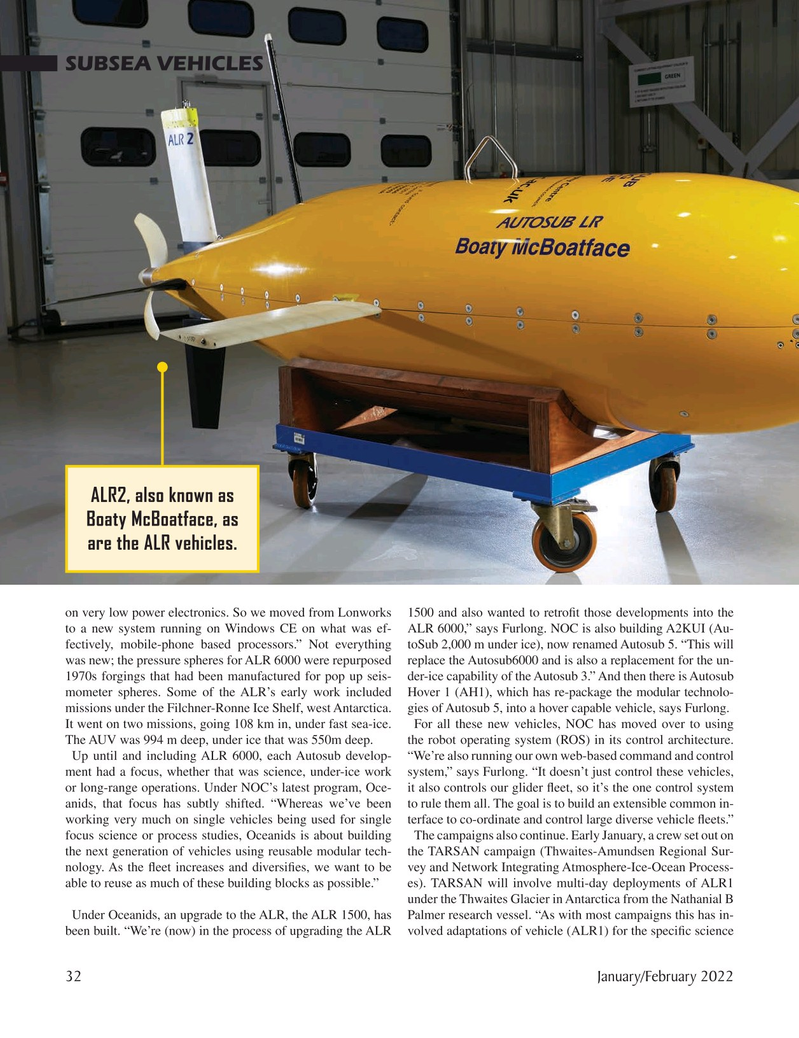
Page 32: of Marine Technology Magazine (January 2022)
Read this page in Pdf, Flash or Html5 edition of January 2022 Marine Technology Magazine
SUBSEA VEHICLES
ALR2, also known as
Boaty McBoatface, as are the ALR vehicles. on very low power electronics. So we moved from Lonworks 1500 and also wanted to retro? t those developments into the to a new system running on Windows CE on what was ef- ALR 6000,” says Furlong. NOC is also building A2KUI (Au- fectively, mobile-phone based processors.” Not everything toSub 2,000 m under ice), now renamed Autosub 5. “This will was new; the pressure spheres for ALR 6000 were repurposed replace the Autosub6000 and is also a replacement for the un- 1970s forgings that had been manufactured for pop up seis- der-ice capability of the Autosub 3.” And then there is Autosub mometer spheres. Some of the ALR’s early work included Hover 1 (AH1), which has re-package the modular technolo- missions under the Filchner-Ronne Ice Shelf, west Antarctica. gies of Autosub 5, into a hover capable vehicle, says Furlong.
It went on two missions, going 108 km in, under fast sea-ice. For all these new vehicles, NOC has moved over to using
The AUV was 994 m deep, under ice that was 550m deep. the robot operating system (ROS) in its control architecture.
Up until and including ALR 6000, each Autosub develop- “We’re also running our own web-based command and control ment had a focus, whether that was science, under-ice work system,” says Furlong. “It doesn’t just control these vehicles, or long-range operations. Under NOC’s latest program, Oce- it also controls our glider ? eet, so it’s the one control system anids, that focus has subtly shifted. “Whereas we’ve been to rule them all. The goal is to build an extensible common in- working very much on single vehicles being used for single terface to co-ordinate and control large diverse vehicle ? eets.” focus science or process studies, Oceanids is about building The campaigns also continue. Early January, a crew set out on the next generation of vehicles using reusable modular tech- the TARSAN campaign (Thwaites-Amundsen Regional Sur- nology. As the ? eet increases and diversi? es, we want to be vey and Network Integrating Atmosphere-Ice-Ocean Process- able to reuse as much of these building blocks as possible.” es). TARSAN will involve multi-day deployments of ALR1 under the Thwaites Glacier in Antarctica from the Nathanial B
Under Oceanids, an upgrade to the ALR, the ALR 1500, has Palmer research vessel. “As with most campaigns this has in- been built. “We’re (now) in the process of upgrading the ALR volved adaptations of vehicle (ALR1) for the speci? c science 32 January/February 2022
MTR #1 (18-33).indd 32 1/25/2022 10:05:32 AM

 31
31

 33
33
